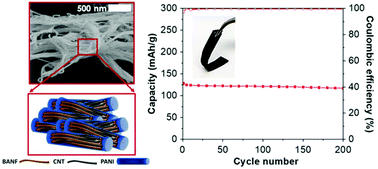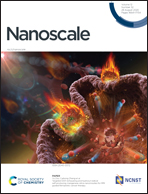Branched aramid nanofiber-polyaniline electrodes for structural energy storage†
Abstract
Strong electrodes with good energy storage capabilities are necessary to accommodate the current needs for structural and flexible electronics. To this end, conjugated polymers such as polyaniline (PANI) have attracted much attention due to their exceptional energy storage performance. However, PANI is typically brittle and requires the use of substrates for structural support. Here, we report a strategy for developing free-standing structural supercapacitor and battery electrodes based on PANI. More specifically, aniline is polymerized in the presence of branched aramid nanofibers (BANFs) and single walled carbon nanotubes (SWCNTs). This results in a network morphology that allows for efficient load transfer and electron transport, leading to electrodes with capacity values up to 128 ± 5 mA h g−1 (vs. a theoretical capacity of 147 mA h g−1), Young's modulus of 4 ± 0.5 GPa, and tensile strength of 40 ± 4 MPa. Furthermore, the charge storage mechanism is investigated, in which both Faradaic and non-Faradaic contributions are observed. This work demonstrates an efficient strategy for designing structural electrodes based on conjugated polymers.



 Please wait while we load your content...
Please wait while we load your content...
